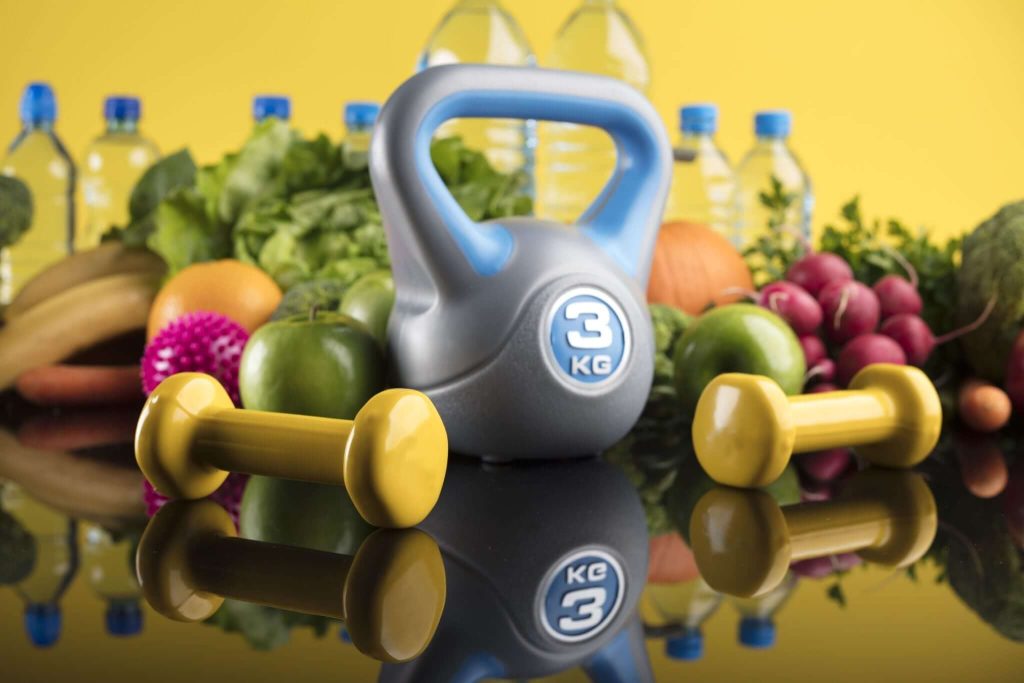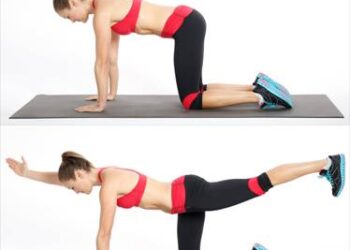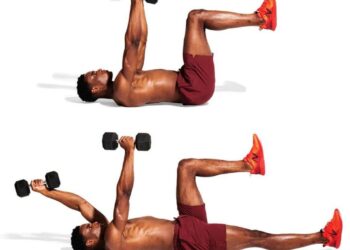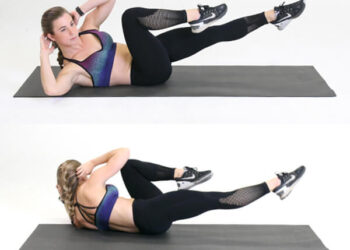
Combining a balanced diet with an accurate workout schedule is the key to achieving fat loss and muscle gain goals. It’s not just about exercising but also closely related to how you build eating habits and improve workout performance. Here are specific steps you can take to achieve your goals:
I. Set Specific Goals
One of the fundamental steps in achieving success in any fitness journey is setting clear and specific goals. These goals act as the guiding light throughout your entire fitness regimen. Here are key components to consider when setting specific fitness goals:
1. Clarity and Precision:
Specificity is crucial. Define your goals in explicit terms, whether it’s losing a certain amount of weight, gaining muscle mass, improving endurance, or a combination. Vague goals make it challenging to track progress.
2. Measurable Objectives:
Ensure your goals are measurable. Incorporate numerical targets or time frames to evaluate your progress effectively. For instance, aiming to lose 10 pounds in two months or increasing your bench press by 20% within six weeks.
3. Achievability and Realism:
Set goals that are realistic and achievable. While aiming high is good, setting unattainable goals may lead to frustration. Consider your current fitness level and time commitment realistically.
4. Relevance to Your Lifestyle:
Align your fitness goals with your lifestyle and overall well-being. Ensure they complement your daily routine and are in harmony with your health aspirations. This alignment fosters commitment and consistency.
5. Setting Timeframes:
Establish a timeline to achieve these goals. A well-defined time frame helps create a sense of urgency and aids in planning the necessary steps and adjustments along the way.
6. Continuous Evaluation and Adaptation:
Regularly assess your progress. If necessary, modify your goals based on your development. Be flexible to adapt to changing circumstances and revise your goals accordingly.
By setting specific and well-defined goals, individuals have a clearer path to follow, making it easier to track progress, stay motivated, and ultimately achieve success in their fitness journey.

II. Establish a Balanced Nutrition Plan
Having a well-structured and balanced nutrition plan is crucial for achieving fitness goals, whether it’s weight loss, muscle gain, or overall health improvement. Here are key points to consider:
1. Understanding Macronutrients:
- Proteins: Essential for muscle repair and growth. Sources include lean meats, fish, tofu, beans, and dairy.
- Carbohydrates: Provide energy. Opt for complex carbs like whole grains, fruits, and vegetables over simple sugars.
- Fats: Necessary for hormone production and overall health. Focus on healthy fats like avocados, nuts, seeds, and olive oil.
2. Portion Control and Caloric Intake:
- Measure portions to maintain control over calorie intake. Balancing energy consumed versus energy expended is crucial for weight management.
- Calculate daily calorie requirements based on your goals, metabolism, activity level, and consult with a nutritionist if necessary.
3. Hydration:
- Water is vital for bodily functions and aids in weight loss. Aim for at least 8-10 glasses of water per day. Adjust intake based on activity level and climate.
4. Meal Planning and Timing:
- Plan well-balanced meals comprising all macronutrients and micronutrients.
- Consider the timing of meals to fuel workouts and aid in recovery. Pre- and post-workout nutrition is crucial for energy and muscle repair.
5. Quality of Food:
- Choose nutrient-dense foods over processed ones. Fresh vegetables, fruits, lean proteins, and whole grains provide essential vitamins and minerals.
- Avoid excessive consumption of processed sugars, trans fats, and highly processed foods.
6. Individualized Approach:
- Customize your nutrition plan based on personal preferences, dietary restrictions, and lifestyle.
- Consider seeking guidance from a registered dietitian or nutritionist to create a tailored plan.
7. Consistency and Monitoring:
- Consistency is key. Stick to your nutrition plan while allowing occasional flexibility to maintain sustainability.
- Regularly monitor progress and make adjustments as needed to ensure the plan aligns with your fitness goals.
8. Mindful Eating:
- Practice mindful eating to be more aware of hunger cues and avoid emotional or binge eating.
- Slow down while eating, savor the food, and listen to your body’s signals of fullness.
9. Supplements:
- Consider supplements to fill nutritional gaps if necessary, but prioritize whole foods whenever possible.
A balanced nutrition plan is a cornerstone of a successful fitness journey. It fuels the body, aids in recovery, and optimizes performance. Creating a plan that suits your goals and lifestyle is essential for sustainable progress toward your fitness objectives.

III. Determine an Effective Workout Schedule
The development of an effective workout schedule is a fundamental aspect of achieving fitness goals. A well-structured and consistent exercise routine helps in enhancing strength, endurance, flexibility, and overall fitness. Here are key elements to consider while determining a workout schedule:
1. Assess Personal Goals and Fitness Level:
- Goal Setting: Define clear and achievable fitness goals, whether it’s weight loss, muscle gain, improved endurance, or overall health enhancement.
- Fitness Level: Evaluate your current fitness level to determine where to begin and gradually progress.
2. Exercise Variety and Balance:
- Cardiovascular Exercise: Incorporate activities that elevate heart rate, such as running, cycling, swimming, or aerobics, for improved cardiovascular health.
- Strength Training: Include resistance exercises targeting major muscle groups using free weights, machines, or bodyweight exercises for muscle development.
- Flexibility and Mobility: Integrate stretching, yoga, or Pilates to improve flexibility, posture, and overall mobility.
3. Frequency, Duration, and Intensity:
- Frequency: Determine the number of workout sessions per week based on fitness goals and availability. Start with a manageable frequency and gradually increase as endurance improves.
- Duration: Plan the length of each workout session based on the type of exercise and fitness level, typically ranging from 30 minutes to an hour.
- Intensity: Adjust workout intensity according to fitness level. Incorporate variations in intensity, such as high-intensity intervals or progressive overload for strength training.
4. Rest and Recovery:
- Rest Days: Schedule rest days to allow muscles to recover and prevent overtraining. Active recovery with light activities like walking or yoga can aid in recovery.
- Sleep: Prioritize quality sleep as it is crucial for muscle repair, hormone regulation, and overall recovery.
5. Consistency and Adaptability:
- Consistency: Stick to the workout schedule consistently to achieve desired results. Develop a routine that aligns with personal commitments and preferences.
- Adaptability: Be flexible and willing to adapt the schedule as needed due to changes in lifestyle, unforeseen circumstances, or fitness progression.
6. Progress Tracking:
- Record Keeping: Maintain a workout log to track progress, including exercises, sets, repetitions, and intensity levels.
- Assessment: Regularly evaluate fitness improvements and make necessary adjustments to the workout schedule to align with evolving goals.
7. Warm-up and Cool-down:
- Warm-up: Always start with a warm-up session to prepare the body for exercise, reducing the risk of injury. Dynamic stretches or light aerobic activities are beneficial.
- Cool-down: Incorporate cool-down exercises to gradually lower heart rate and stretch muscles, aiding in muscle recovery and flexibility.
8. Professional Guidance:
- Consultation: Seek guidance from fitness professionals, personal trainers, or coaches to create a tailored workout schedule based on individual needs, limitations, and goals.
- Progression: Gradually progress the workout schedule to challenge the body and avoid plateaus, considering adjustments in exercises, intensity, or duration.
A well-planned workout schedule is crucial for achieving fitness objectives. It provides structure, consistency, and adaptability, fostering sustainable progress and overall health improvement.

IV. Combine Nutrition and Exercise
The synergy between nutrition and exercise plays a pivotal role in achieving health and fitness goals. The integration of a well-balanced diet with an effective workout regimen can significantly impact overall well-being. Here are some key elements to consider when combining nutrition and exercise:
1. Nutritional Requirements:
- Caloric Intake: Determine daily calorie needs based on individual goals, metabolism, activity level, and body composition.
- Macronutrients: Understand the significance of carbohydrates, proteins, and fats in providing energy, supporting muscle repair, and overall health.
- Micronutrients: Ensure adequate intake of vitamins, minerals, and antioxidants for optimal bodily functions and overall health.
2. Meal Timing and Composition:
- Pre-Workout Nutrition: Consume a balanced meal comprising carbohydrates, proteins, and fats 1-2 hours before exercising to fuel the body and optimize performance.
- Post-Workout Nutrition: Consume a combination of protein and carbohydrates within 30-60 minutes after exercise to facilitate muscle recovery and replenish glycogen stores.
3. Hydration:
- Water Intake: Stay adequately hydrated throughout the day, especially during workouts, to regulate body temperature, transport nutrients, and support overall bodily functions.
4. Nutritional Strategies for Exercise Goals:
- Weight Loss: Focus on creating a caloric deficit by consuming nutrient-dense foods while being mindful of portion sizes and avoiding excessive calorie intake.
- Muscle Gain: Ensure sufficient protein intake to support muscle repair and growth, paired with a balanced diet rich in essential nutrients.
5. Balanced Diet and Whole Foods:
- Whole Foods: Emphasize whole, unprocessed foods such as fruits, vegetables, lean proteins, whole grains, and healthy fats to provide essential nutrients.
- Portion Control: Practice mindful eating and portion control to maintain a balanced diet aligned with individual nutritional needs.
6. Personalized Nutrition Plans:
- Consultation: Seek guidance from registered dietitians or nutritionists to create personalized nutrition plans tailored to individual goals, dietary preferences, and health conditions.
- Adherence: Maintain consistency in following the nutrition plan alongside the workout routine to achieve desired results effectively.
7. Nutritional Education and Awareness:
- Education: Continuously educate oneself about nutritional principles, understanding food labels, and making informed dietary choices.
- Healthy Habits: Develop sustainable dietary habits that align with long-term health and fitness goals.
8. Tracking and Adjustments:
- Food Journaling: Keep a food diary or use tracking apps to monitor dietary intake and identify patterns, aiding in making necessary adjustments.
- Reevaluation: Regularly reevaluate nutritional strategies and make adjustments to the diet plan based on progress and changing goals.
9. Supplements and Vitamins:
- Supplementation: Consider the use of supplements or vitamins to address specific nutrient deficiencies, if recommended by healthcare professionals.
- Caution: Use supplements judiciously and consult healthcare professionals before incorporating them into the diet plan.
The combination of proper nutrition and exercise forms the cornerstone of a healthy lifestyle. By understanding how nutrition complements physical activity, individuals can optimize their fitness journey, achieve goals, and promote overall well-being.

V. Perform Regular Assessments
Performing regular assessments is an integral part of any health and fitness journey. It involves evaluating progress, identifying areas of improvement, and adjusting strategies to align with goals. Here’s a breakdown of key aspects regarding regular assessments:
1. Tracking Progress:
- Measurements: Monitor changes in body weight, body fat percentage, muscle mass, and other relevant measurements to gauge progress accurately.
- Fitness Tests: Conduct periodic fitness assessments, such as strength tests, endurance tests, and flexibility assessments, to track improvements in physical performance.
2. Evaluation Metrics:
- Goal Review: Assess whether short-term and long-term goals are being met and reevaluate if necessary to ensure they remain achievable and realistic.
- Behavioral Changes: Evaluate lifestyle modifications, dietary habits, exercise adherence, and other behavioral changes to determine their impact on overall progress.
3. Documentation and Records:
- Maintain Records: Keep detailed records of workout routines, dietary intake, progress photos, and any challenges faced during the journey to have a comprehensive overview.
- Journaling: Maintain a journal to track emotions, energy levels, sleep patterns, and any correlations with fitness and dietary changes.
4. Self-Assessment Tools:
- Use of Technology: Utilize fitness apps, wearable devices, or online tools to track physical activity, nutritional intake, and overall progress conveniently.
- Feedback Loops: Take advantage of self-assessment tools that provide feedback on performance, helping to adjust strategies accordingly.
5. Professional Guidance:
- Consultation: Seek guidance from fitness trainers, nutritionists, or healthcare professionals to undergo comprehensive assessments and receive expert advice.
- Health Check-ups: Schedule regular health check-ups to evaluate overall health, identify any underlying issues, and ensure fitness routines align with individual health needs.
6. Adjustments and Modifications:
- Evaluate Results: Analyze assessment data to identify trends, areas of improvement, or potential setbacks in the fitness journey.
- Adapt Strategies: Based on assessment findings, make necessary adjustments to workout routines, nutritional plans, or lifestyle choices to optimize progress.
7. Celebrate Milestones:
- Acknowledge Achievements: Celebrate milestones and accomplishments, whether they’re significant weight loss, improved strength, or lifestyle changes, to stay motivated and focused.
- Motivation: Use achieved milestones as motivation to continue pursuing fitness goals and maintain a positive mindset throughout the journey.
8. Reassessment Timelines:
- Periodic Reviews: Establish regular intervals for reassessments, considering factors like fitness goals, timelines, and the rate of progress.
- Flexible Adaptation: Be flexible in reassessment timelines, allowing adjustments based on changes in goals or unexpected challenges.
Regular assessments not only track progress but also provide valuable insights into the effectiveness of chosen strategies. They help in making informed decisions, adapting plans, and staying motivated on the path toward achieving health and fitness goals.

VI. Allow Time for Rest and Recovery
Rest and recovery are crucial components of any effective fitness program. This segment involves understanding the significance of allowing the body adequate time to recuperate between workouts and its impact on overall performance and health. Here’s a concise breakdown:
1. Importance of Rest:
- Muscle Repair: Rest permits muscles to recover and repair from the stress induced during workouts, facilitating muscle growth and strength development.
- Injury Prevention: Adequate rest reduces the risk of overuse injuries caused by repetitive strain on muscles, tendons, and joints.
- Energy Restoration: Rest restores energy levels, preventing fatigue, burnout, and mental exhaustion often associated with prolonged physical activity.
2. Differentiation between Rest and Active Recovery:
- Rest Days: Designated periods for complete physical rest, allowing the body to recover without engaging in intense workouts or strenuous activities.
- Active Recovery: Incorporating low-intensity exercises, such as light yoga, gentle stretching, or leisurely walks, to promote blood circulation and aid in recovery without causing additional stress.
3. Understanding Sleep:
- Quality Sleep: Highlight the importance of quality sleep in muscle repair, hormone regulation, and overall physical and mental rejuvenation.
- Sleep Patterns: Emphasize the need for consistent sleep patterns, aiming for the recommended 7-9 hours of sleep per night.
4. Factors Affecting Recovery:
- Nutrition: Proper nutrition, including adequate protein intake and hydration, plays a vital role in muscle repair and recovery.
- Stress Management: Manage stress levels as high stress can hinder recovery, impacting sleep quality and overall physical well-being.
5. Recovery Techniques:
- Foam Rolling: Utilize foam rolling or self-myofascial release techniques to alleviate muscle tightness, improve flexibility, and aid in recovery.
- Massage and Stretching: Incorporate regular massages or stretching sessions to enhance blood flow, alleviate muscle tension, and improve flexibility.
6. Listening to Your Body:
- Recognizing Fatigue: Acknowledge signs of overtraining or fatigue, such as persistent soreness, decreased performance, or changes in mood, and respond accordingly.
- Adaptation: Adjust workout intensity or frequency based on individual recovery rates and bodily cues to avoid burnout.
7. Scheduling Rest Days:
- Strategic Rest: Plan scheduled rest days into workout routines, ensuring adequate time for the body to recuperate and adapt to training stress.
- Active Recovery Days: Integrate light workouts or activities on rest days for those who prefer staying active without exerting significant physical strain.
8. Balancing Training Intensity:
- Periodization: Implement training periodization, alternating between high-intensity workouts and recovery periods to prevent plateauing and optimize performance.
- Deload Weeks: Incorporate deload weeks periodically, reducing training volume or intensity to allow the body extended recovery.
9. Mental Restoration:
- Mindfulness Practices: Include mindfulness meditation, deep breathing exercises, or activities like yoga to promote mental relaxation and reduce stress, contributing to overall recovery.
10. Hydration and Nutrition:
- Hydration: Emphasize the importance of staying hydrated to facilitate nutrient transport, temperature regulation, and overall recovery.
- Recovery Nutrition: Consume post-workout meals or supplements containing the necessary nutrients, focusing on protein and carbohydrates, to aid in muscle repair and glycogen replenishment.
Rest and recovery are not merely breaks from physical activity but integral components of a well-rounded fitness regimen. They play a pivotal role in enhancing performance, preventing injuries, and ensuring sustainable progress toward fitness goals.

VII. Seek Expert Guidance:
- Always seek support from nutritionists and trainers for guidance and necessary adjustments.
In summary, balancing nutrition and exercise is the key to achieving fat loss and muscle gain goals. Smartly combining these two factors will yield the most effective and favorable results for your health and physique.
Source: Admin compiled from the Internet





















